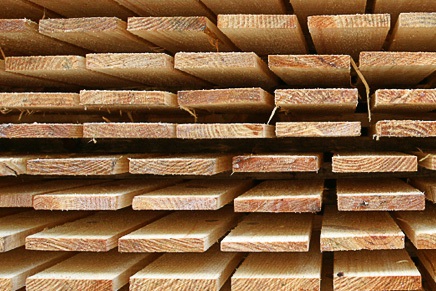Sawn timber is a timber product that has been sawn from at least two sides. Sawn timber is differentiated based on quality class and type of timber used thereby making it possible to choose the optimal solution required.
As wood is a natural material, its appearance and physical qualities are subject to variations. The properties are mostly affected by the type of tree and its growing conditions. In general, pine and spruce (i.e. conifer trees) are the trees most commonly used for extracting sawn timber for building purposes. This is especially true for construction as conifer trees are more resistant to humid environments. The strength properties of pine and spruce are broadly similar as both trees are usually not assessed as distinct from one another when making strength calculations. The strength properties of timber materials are adversely affected by the dimensions, number, location and shape of branches. Timber’s strength qualities are also diminished by wanes and defects caused by rot.
Sawn and planed spruce and pine materials can be told apart as pine contains more resin and has a darker complexion. The pine’s rings are more distinct with branch roots darker. The exterior appearance of wood is also affected by sawing traces and by the way the surface has been treated.
Abscess poses the greatest possible danger to timber. The spruce is less susceptible to abscess than pine, which has a darker core more resistant than its outer layers. The abscess resistance of timber can be enhanced by applying chemical protective agents. For the protection of outer layers chemicals can be applied with a brush. A more durable protection is provided by pressurized immersion whereby the protective agents are forced deep into the core fibbers of the tree. Such timber is called „impregnated timber“. The unorthodox cell structure of spruce will not permit the use of pressurized immersion.
Heat treated timber
Heat treated timber is gained by exposing the timber to high (180–230 °C) temperatures. A process like this will affect the chemical and biological structure of the wood, thereby impacting its quality.
Heat treated timber is more resistant to abscess, deformations caused by humidity are diminished, weather-proofing is enhanced, weight and bending strength are decreased and resin is steamed away.
The process utilises only heat and steam – no chemicals or other synthetic components are applied.
Usage
Heat treated timber is used in both interior, exterior and sauna linings. It can be used as floor boards or for making doors and windows.
Heat treated timber should not be used in contact with ground which can lead to saturation with water.
Sawn timber
| 19x100mm KD SCHAAL/HT | 47x100mm KD AB/HT |
| 19x100mm KD VI/HT | 47x150mm KD AB/HT |
| 22x100mm KD AB/HT | 47x200mm KD AB/HT |
| 22x100mm KD VI/HT | 50x50mm KD AB/HT |
| 22x100mm KD SCHAAL/HT | 50x50mm air-dry AB |
| 22x100mm KD SCHAAL/D/HT | 50x100mm KD AB/HT |
| 22x100mm air-dry B | 50x100mm KD VI/HT |
| 22x150mm KD VI/HT | 50x100mm air-dry AB |
| 22x150mm KD AB/HT | 50x150mm KD AB/HT |
| 22x150mm air-dry AB | 50x150mm KD VI/HT |
| 22x200mm KD VI/HT | 50x150mm air-dry AB |
| 25x50mm KD VI/HT | 50x200mm KD AB/HT |
| 25x100mm KD VI/HT | 50x200mm KD VI/HT |
| 25x100mm AB/HT | 50x200mm air-dry AB |
| 25x100mm KD SCHAAL/D/HT | 75x200mm air-dry AB |
| 25x100mm KD SCHAAL/D/HT | 100x100mm air-dry AB |
| 25x150mm KD VI/HT | 150x150mm air-dry AB |
| 200x200mm air-dry AB |
Timber quality symbols
KD – dried timber 18%
Air-dry – air-dry timber, moisture 20%
AB – square-edged timber, some dead knots are possible
VI – square-edged timber, dead knots and some alteration of colour is possible
SCHAAL – wane-edged timber, dead knots are possible
SCHAAL/D – wane-edged timber with alteration of colour, dead knots are possible
HT – heat-treated timber, complies with the requirements of Plant Production Inspectorate




